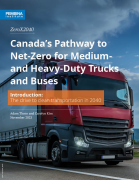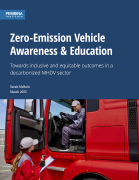Freight, or goods movement by truck, rail, ship or plane, is a too-often overlooked source of carbon emissions. As of 2015 it accounted for 10.5% of total emissions in Canada, and within the transportation sector — which at 24% is the second highest source of emissions in Canada — freight is the fastest growing segment.
In fact, Canada’s 2nd Biennial Report on Climate Change projects that freight emissions will eclipse passenger emissions around 2030. These largely unchecked emissions could prove to be a huge roadblock for Canada to meet its climate targets and live up to its Paris Agreement commitment.
This report explores the role that freight plays in the Canadian economy, and how it contributes to the country's emissions profile. It also looks at the policy landscape across the country that shapes the freight sector, what actors are involved and finally, highlights existing actions and policies, promising experiences in other jurisdictions and summarizes potential challenges and opportunities for reducing emissions further in Canada.






